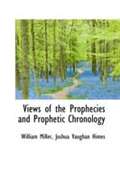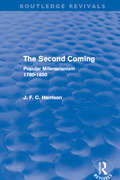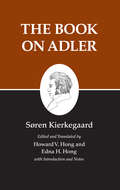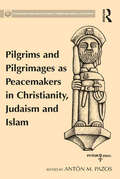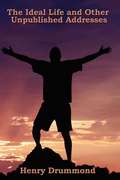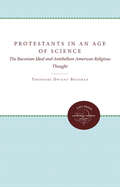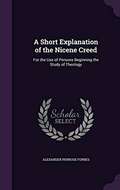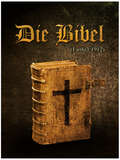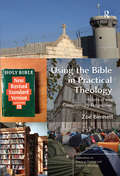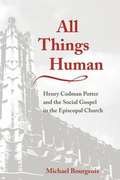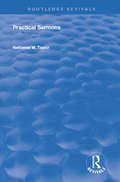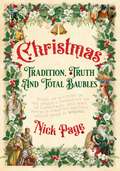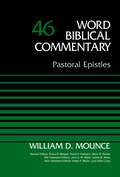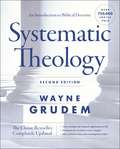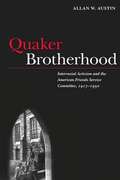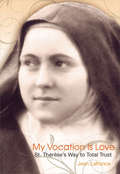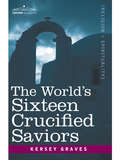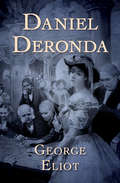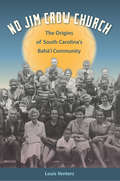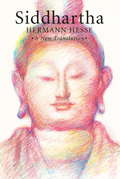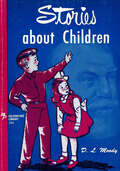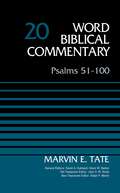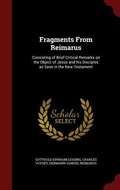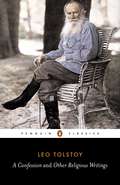- Table View
- List View
Views of the Prophecies and Prophetic Chronology
by Joshua V. Himes William MillerRather than a book written as such, this work is a collection of lectures and letters written by Mr. Miller, and put into book form by Mr. Himes. Spelling as in original.
The Second Coming: Popular Millenarianism, 1780-1850 (Routledge Revivals)
by J. F. HarrisonFirst published in 1979, The Second Coming is an experiment in the writing of popular history – a contribution to the history of the people who have no history and an exploration of some of the ideas, beliefs and ways of thinking of ordinary men and women in the late eighteenth and first half of the nineteenth centuries. Millenarianism is a conceptual tool with which to explore some aspects of popular thought and culture. It is also seen as an ideology of social change and as a continuing tradition, traced from the end of the seventeenth century to the 1790s, and is shown to be embedded in folk culture. Abundant in rich and lively descriptions of such colourful characters as Richard Brothers, Joanna Southcott, John Wroe, Zion Ward and Sir William Courtenay, as well as studies of the Shakers, early Mormons and Millerites, the result is a window into the world of ordinary people in the Age of Romanticism.
Kierkegaard's Writings, XXII
by Søren Kierkegaard Edna H. Hong Howard V. HongAs a spiritual autobiography, Kierkegaard's The Point of View for My Work as an Author stands among such great works as Augustine's Confessions and Newman's Apologia pro Vita Sua. Yet Point of View is neither a confession nor a defense; it is an author's story of a lifetime of writing, his understanding of the maze of greatly varied works that make up his oeuvre. Upon the imminent publication of the second edition of Either/Or, Kierkegaard again intended to cease writing. Now was the time for a direct "report to history" on the authorship as a whole. In addition to Point of View, which was published posthumously, the present volume also contains On My Work as an Author, a contemporary substitute, and the companion piece Armed Neutrality.
Pilgrims and Pilgrimages as Peacemakers in Christianity, Judaism and Islam (Compostela International Studies in Pilgrimage History and Culture)
by Antón M. PazosPilgrimages can be analysed as acts of conflict - such as the Crusades - or also as platforms for relationship building and rapprochement between religions. With a set of contributions from leading experts in the field, this book explores the concept of pilgrimage in Christianity, Judaism and Islam. Some specific examples of pilgrimages that helped to strengthen links between different religions or civilisations are explored, ranging from Europe to Asia and from the Middle Ages to the twentieth century. Even though every pilgrimage that is investigated here has helped to link different worlds, the case studies show that this relationship rarely led to a better in inter-understanding. Nowadays, peaceful coexistence seems to be its greatest achievement.
The Ideal Life and Other Unpublished Addresses
by Henry DrummondThe addresses which make up this volume were written by Professor Drummond between the years 1876 and 1881, and are now published in the hope that they may continue his work. Included here are "Ill-Temper," "Why Christ Must Depart," "Going to the Father," "The Eccentricity of Religion," "To Me to Live Is Christ," "Clairvoyance," "The Three Facts of Sin," "The Three Facts of Salvation," "Marvel Not," "Penitence," "The Man After God's Own Heart," "What is Your Life?," "What is God's Will?," "The Relation of the Will of God to Sanctification," and "How to Know the Will of God."
Protestants in an Age of Science: The Baconian Ideal and Antebellum American Religious Thought
by Theodore Dwight BozemanSince Princeton College and Princeton Seminary were major radii of Realist influence, the conservative Presbyterianism headquartered there is an ideal choice for a case study in the American impact of Baconianism. Presbyterian thinkers, already committed to a synthesis of Protestant religion and Newtonian science, were afforded with additional means of elaborating a doxological version of natural science and of defending it against naturalism and other enemies of Christian faith.Originally published in 1977.A UNC Press Enduring Edition -- UNC Press Enduring Editions use the latest in digital technology to make available again books from our distinguished backlist that were previously out of print. These editions are published unaltered from the original, and are presented in affordable paperback formats, bringing readers both historical and cultural value.
A Short Explanation of the Nicene Creed: For the Use of Persons Beginning the Study of Theology
by Alexander Penrose ForbesThis work has been selected by scholars as being culturally important, and is part of the knowledge base of civilization as we know it. This work was reproduced from the original artifact, and remains as true to the original work as possible. Therefore, you will see the original copyright references, library stamps (as most of these works have been housed in our most important libraries around the world), and other notations in the work. This work is in the public domain in the United States of America, and possibly other nations. Within the United States, you may freely copy and distribute this work, as no entity (individual or corporate) has a copyright on the body of the work.As a reproduction of a historical artifact, this work may contain missing or blurred pages, poor pictures, errant marks, etc. Scholars believe, and we concur, that this work is important enough to be preserved, reproduced, and made generally available to the public. We appreciate your support of the preservation process, and thank you for being an important part of keeping this knowledge alive and relevant.
Die Bibel: Neubearbeitung Der Ungekürzten Originalfassung (Classics To Go #408)
by Martin LutherDie Lutherbibel ist eine Übersetzung des Alten und Neuen Testaments der Bibel aus der althebräischen, der aramäischen bzw. der altgriechischen bzw. der Sprache in die deutsche Sprache (Frühneuhochdeutsch). Die Übersetzung wurde von Martin Luther unter Mitarbeit weiterer Theologen angefertigt. Im September 1522 war eine erste Auflage des Neuen Testamentes fertig.
Using the Bible in Practical Theology: Historical and Contemporary Perspectives (Explorations in Practical, Pastoral and Empirical Theology)
by Zoë BennettExploring how the Bible may be appropriately used in practical and public theology, this book looks at types of modern practical theology with specific emphasis on the use of the Bible. Bennett juxtaposes the diversity of modern practical theology with the work of leading nineteenth-century public 'theologian', John Ruskin, and then assesses the contribution of this analysis to some modern issues of public importance in which the Bible is used. The final chapter offers a framework for a biblically informed critical practical theology which draws on the writer's experience and invites the readers to engage their own.
All Things Human: Henry Codman Potter and the Social Gospel in the Episcopal Church
by Michael BourgeoisIn addition to being the sixth bishop of the Diocese of New York, Henry Codman Potter (1835-1908) was a prominent voice in the Social Gospel movement of the late nineteenth and early twentieth centuries. This book, the first in-depth study of Potter's life and work, examines his career in the Episcopal church as well as the origins and legacy of his progressive social views. As industrialization and urbanization spread in the nineteenth century, the Social Gospel movement sought to apply Christian teachings to effect improvements in the lives of the less fortunate. Potter was firmly in this tradition, concerning himself especially with issues of race, the place of women in society, questions of labor and capital, and what he called "political righteousness." Placing Potter against the wider backdrop of nineteenth-century American Protestantism, Bourgeois explores the experiences and influences that led him to espouse these socially conscious beliefs, to work for social reform, and to write such works as Sermons of the City (1881) and The Citizen in His Relation to the Industrial Situation (1902). In telling Potter's remarkable story, All Things Human stands as a valuable contribution to intellectual and religious history as well as an exploration of the ways in which religion and society interact.
Practical Sermons (Routledge Revivals)
by Nathaniel William TaylorThis book was originally published in 1858. Dr. Taylor was for ten years pastor of the Center Church in New Haven, Connecticut, before called to the Theological Chair in Yale College. These sermons were written during this period, and preached in the ordinary course of ministerial duty. Many of them had reference to a state of deep religious interest in his congregation, with which his ministry was so frequently blessed.
Christmas: Tradition, Truth and Total Baubles
by Nick PageWhy is Christmas the way it is? How did we get from the birth of Jesus to everyone pushing their credit card and their belts to their maximum extent? Starting with the events surrounding Jesus' birth, this book takes us through centuries of commemoration, celebration and over-consumption. Along the way we'll find out why we eat turkey, how an obscure Turkish saint turned into a man flying a sleigh, and why that tree in your house should really contain an apple and a snake. Combining in-depth historical research, cheerfully irreverent humour and cutting-edge guesswork, Nick Page explores what this festival really means, and how we can get back to something real and true beneath all that wrapping.
Pastoral Epistles, Volume 46 (Word Biblical Commentary)
by Bruce M. Metzger Ralph P. Martin Lynn Allan Losie David Allen Hubbard Glenn W. Barker John D. Watts James W. WattsThe Word Biblical Commentary delivers the best in biblical scholarship, from the leading scholars of our day who share a commitment to Scripture as divine revelation. This series emphasizes a thorough analysis of textual, linguistic, structural, and theological evidence. The result is judicious and balanced insight into the meanings of the text in the framework of biblical theology. These widely acclaimed commentaries serve as exceptional resources for the professional theologian and instructor, the seminary or university student, the working minister, and everyone concerned with building theological understanding from a solid base of biblical scholarship.Overview of Commentary OrganizationIntroduction—covers issues pertaining to the whole book, including context, date, authorship, composition, interpretive issues, purpose, and theology.Each section of the commentary includes:Pericope Bibliography—a helpful resource containing the most important works that pertain to each particular pericope.Translation—the author’s own translation of the biblical text, reflecting the end result of exegesis and attending to Hebrew and Greek idiomatic usage of words, phrases, and tenses, yet in reasonably good English.Notes—the author’s notes to the translation that address any textual variants, grammatical forms, syntactical constructions, basic meanings of words, and problems of translation.Form/Structure/Setting—a discussion of redaction, genre, sources, and tradition as they concern the origin of the pericope, its canonical form, and its relation to the biblical and extra-biblical contexts in order to illuminate the structure and character of the pericope. Rhetorical or compositional features important to understanding the passage are also introduced here.Comment—verse-by-verse interpretation of the text and dialogue with other interpreters, engaging with current opinion and scholarly research.Explanation—brings together all the results of the discussion in previous sections to expose the meaning and intention of the text at several levels: (1) within the context of the book itself; (2) its meaning in the OT or NT; (3) its place in the entire canon; (4) theological relevance to broader OT or NT issues.General Bibliography—occurring at the end of each volume, this extensive bibliographycontains all sources used anywhere in the commentary.
Systematic Theology, Second Edition: An Introduction to Biblical Doctrine
by Wayne A. GrudemThis new edition of Systematic Theology by Wayne Grudem is one of the most important resources for helping you understand Scripture and grow as a Christian.The most widely used resource of the last 25 years in its area, Systematic Theology has been thoroughly revised and expanded for the first time while retaining the features that have made it the standard in its field: clear explanations, an emphasis on each doctrine's scriptural basis, and practical applications to daily life.With nearly 250 pages of new content and revisions, this new edition now includes the following distinctive features:Updated analysis of recent controversies within evangelical theology, including the eternal relationship between the Father and the Son in the Trinity, the role of women in the church, miraculous gifts of the Holy Spirit, and contemporary worship music.New discussion and critiques of recent theological controversies situated outside of traditional evangelical theology, such as open theism, the "new perspective on Paul," Molinism (or "middle knowledge"), "Free Grace" theology, and the preterist view of Christ's second coming.Completely revised chapter on the clarity of Scripture.Completely revised chapter on creation and evolution, including a longer critique of theistic evolution and an extensive discussion on the age of the earth.New discussion of how biblical inerrancy applies to some specific "problem verses" in the Gospels.Additional material explaining evangelical Protestant differences with Roman Catholicism, Protestant liberalism, and Mormonism.Completely updated bibliographies.All Scripture quotations updated from RSV to ESV.Updated section on contemporary worship music.Numerous other updates and corrections.Part of the brilliance of Systematic Theology has been its simplicity and ease of use. Each chapter follows the same structure: discussion of the doctrine being considered, an explanation of that doctrine's biblical support and possible objections, followed by personal application and key terms to know for personal growth. Chapters also include a Scripture memory passage, references to other literature on the topic, and suggested hymns and worship songs.If you think theology is hard to understand or boring, then this new edition of Systematic Theology will change your mind.
Quaker Brotherhood: Interracial Activism and the American Friends Service Committee, 1917-1950
by Allan W. AustinThe Religious Society of Friends and its service organization, the American Friends Service Committee (AFSC) have long been known for their peace and justice activism. The abolitionist work of Friends during the antebellum era has been well documented, and their contemporary anti-war and anti-racism work is familiar to activists around the world. Quaker Brotherhood is the first extensive study of the AFSC's interracial activism in the first half of the twentieth century, filling a major gap in scholarship on the Quakers' race relations work from the AFSC's founding in 1917 to the beginnings of the civil rights movement in the early 1950s. Allan W. Austin tracks the evolution of key AFSC projects such as the Interracial Section and the American Interracial Peace Committee, which demonstrate the tentativeness of the Friends' activism in the 1920s, as well as efforts in the 1930s to make scholarly ideas and activist work more theologically relevant for Friends. Documenting the AFSC's efforts to help European and Japanese American refugees during World War II, Austin shows that by 1950, Quakers in the AFSC had honed a distinctly Friendly approach to interracial relations that combined scholarly understandings of race with their religious views. In tracing the transformation of one of the most influential social activist groups in the United States over the first half of the twentieth century, Quaker Brotherhood presents Friends in a thoughtful, thorough, and even-handed manner. Austin portrays the history of the AFSC and race--highlighting the organization's boldness in some aspects and its timidity in others--as an ongoing struggle that provides a foundation for understanding how shared agency might function in an imperfect and often racist world. Highlighting the complicated and sometimes controversial connections between Quakers and race during this era, Austin uncovers important aspects of the history of Friends, pacifism, feminism, American religion, immigration, ethnicity, and the early roots of multiculturalism.
My Vocation is Love
by Jean LafranceFind your way to total trust in God with Saint Thérèse of Lisieux as your guide. In this spiritual biography blossoming with rich commentary on Thérèse's reflections, and emerging from the Carmelite tradition, we are offered glimpses into her interior life.
The World's Sixteen Crucified Saviors: Christianity before Christ
by Kersey GravesKhrisna of India. Thammuz of Syria. Esus of the Celtic Druids. Mithra of Persia. Quexalcoati of Mexico. All were crucified gods, and all met their fates hundreds of years before Jesus appeared on the scene. In this foundational work of modern atheism, American spiritualist KERSEY GRAVES (1813-1883) breaks the Christ myth down into its component parts and ably demonstrates how the story of Jesus has its roots in the depths of antiquity. Here you'll read about the surprising prevalence throughout global folklore of: . the miraculous and immaculate conception of the gods . stars that point out the time and place of a savior's birth . angels, shepherds, and magi visiting an infant savior . the 25th of December as the universal birth date of gods . saviors who descend into Hell . and much more. This is essential reading for students of comparative mythology and modern freethinkers. Also available from Cosimo: Graves's The Biography of Satan and The Bible of Bible.
Daniel Deronda: Volume 2...
by George EliotTwo members of the British upper class are drawn together--and torn asunder--by their search for self in this "startling and unexpected novel" (A. S. Byatt). As a true scion of the English gentry, Daniel Deronda has been raised with the expectation that he will take his rightful place in society--despite being possessed of a disquiet he cannot ignore. When he spies the beautiful Gwendolen Harleth, he senses a similarly dissatisfied soul in her. However, their shared discontent takes them in vastly different directions. Upon discovering some unsettling possibilities about his own ancestry, Daniel is drawn into the world of Judaism and the discipline and spiritual growth it entails while Gwendolen fiercely desires to be freed from her oppressive marriage to noble Henleigh Mallinger Grandcourt and rectify mistakes from her past in order to live on her own terms. The two find their paths intertwined as they seek life outside of their station. Set at the height of the British Empire, where racism, sexism, and the strict hierarchy of an absolutely uncompromising society held sway, Daniel Deronda is a jarring, emotional tale of a time and place often romanticized but rarely examined in all its facets, both glorious and grotesque. This ebook has been professionally proofread to ensure accuracy and readability on all devices.
No Jim Crow Church: The Origins of South Carolina's Bahá'í Community
by Louis Venters"A richly detailed study of the rise of the Bahá’í Faith in South Carolina. There isn’t another study out there even remotely like this one."--Paul Harvey, coauthor of The Color of Christ: The Son of God and the Saga of Race in America "A pioneering study of how and why the Bahá’í Faith became the second largest religious community in South Carolina. Carefully researched, the story told here fills a significant gap in our knowledge of South Carolina's rich and diverse religious history."--Charles H. Lippy, coauthor of Religion in Contemporary America The emergence of a cohesive interracial fellowship in Jim Crow-era South Carolina was unlikely and dangerous. However, members of the Bahá’í Faith in the Palmetto State rejected segregation, broke away from religious orthodoxy, and defied the odds, eventually becoming the state’s largest religious minority. The religion, which emphasizes the spiritual unity of all humankind, arrived in the United States from the Middle East at the end of the nineteenth century via urban areas in the Northeast and Midwest. Expatriate South Carolinians converted and when they returned home, they brought their newfound religion with them. Despite frequently being the targets of intimidation, and even violence, by neighbors, the Ku Klux Klan, law enforcement agencies, government officials, and conservative clergymen, the Bahá’ís remained resolute in their faith and their commitment to an interracial spiritual democracy. In the latter half of the twentieth century, their numbers continued to grow, from several hundred to over twenty thousand. In No Jim Crow Church, Louis Venters traces the history of South Carolina’s Bahá’í community from its early origins through the civil rights era and presents an organizational, social, and intellectual history of the movement. He relates developments within the community to changes in society at large, with particular attention to race relations and the civil rights struggle. Venters argues that the Bahá’ís in South Carolina represented a significant, sustained, spiritually-based challenge to the ideology and structures of white male Protestant supremacy, while exploring how the emergence of the Bahá’í Faith in the Deep South played a role in the cultural and structural evolution of the religion.
Siddhartha: Siddhartha
by Sherab Chodzin Kohn Hermann HesseThis classic of twentieth-century literature chronicles the spiritual evolution of a man living in India at the time of the Buddha--a spiritual journey that has inspired generations of readers. Here is a fresh translation from Sherab Chödzin Kohn, a gifted translator and longtime student of Buddhism and Eastern philosophy. Kohn's flowing, poetic translation conveys the philosophical and spiritual nuances of Hesse's text, paying special attention to the qualities of meditation experience. This edition also includes an introduction exploring Hesse's own spiritual journey as evidenced in his journals and personal letters.
Stories About Children (Colportage Library #226)
by Dwight L. MoodyStories About Children contains remarkable anecdotes connected with child life, which will touch the heart of the child and parent alike. These stories are perfect for illustrating gospel truths to children.
Stories About Children (Colportage Library #226)
by Dwight L. MoodyStories About Children contains remarkable anecdotes connected with child life, which will touch the heart of the child and parent alike. These stories are perfect for illustrating gospel truths to children.
Psalms 51-100, Volume 20 (Word Biblical Commentary #Vol. 20)
by Ralph P. Martin David Allen Hubbard Glenn W. Barker John D. Watts Marvin TateThe Word Biblical Commentary delivers the best in biblical scholarship, from the leading scholars of our day who share a commitment to Scripture as divine revelation. This series emphasizes a thorough analysis of textual, linguistic, structural, and theological evidence. The result is judicious and balanced insight into the meanings of the text in the framework of biblical theology. These widely acclaimed commentaries serve as exceptional resources for the professional theologian and instructor, the seminary or university student, the working minister, and everyone concerned with building theological understanding from a solid base of biblical scholarship.Overview of Commentary OrganizationIntroduction—covers issues pertaining to the whole book, including context, date, authorship, composition, interpretive issues, purpose, and theology.Each section of the commentary includes:Pericope Bibliography—a helpful resource containing the most important works that pertain to each particular pericope.Translation—the author’s own translation of the biblical text, reflecting the end result of exegesis and attending to Hebrew and Greek idiomatic usage of words, phrases, and tenses, yet in reasonably good English.Notes—the author’s notes to the translation that address any textual variants, grammatical forms, syntactical constructions, basic meanings of words, and problems of translation.Form/Structure/Setting—a discussion of redaction, genre, sources, and tradition as they concern the origin of the pericope, its canonical form, and its relation to the biblical and extra-biblical contexts in order to illuminate the structure and character of the pericope. Rhetorical or compositional features important to understanding the passage are also introduced here.Comment—verse-by-verse interpretation of the text and dialogue with other interpreters, engaging with current opinion and scholarly research.Explanation—brings together all the results of the discussion in previous sections to expose the meaning and intention of the text at several levels: (1) within the context of the book itself; (2) its meaning in the OT or NT; (3) its place in the entire canon; (4) theological relevance to broader OT or NT issues.General Bibliography—occurring at the end of each volume, this extensive bibliographycontains all sources used anywhere in the commentary.
Fragments from Reimarus: Consisting of Brief Critical Remarks on the Object of Jesus and his Disciples as Seen in the New Testament
by Hermann Samuel ReimarusFragments from Reimarus: Consisting of Brief Critical Remarks on the Object of Jesus and his Disciples as Seen in the New Testament by Rev. Charles Voysey.
A Confession and Other Religious Writings
by Leo TolstoyDescribing Tolstoy's crisis of depression and estrangement from the world, A Confession (1879) is an autobiographical work of exceptional emotional honesty. By the time he was fifty, Tolstoy had already written the novels that would assure him of literary immortality; he had a wife, a large estate and numerous children; he was 'a happy man' and in good health - yet life had lost its meaning. In this poignant confessional fragment, he records a period of his life when he began to turn away from fiction and aesthetics, and to search instead for 'a practical religion not promising future bliss, but giving bliss on earth'.
